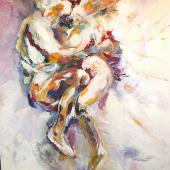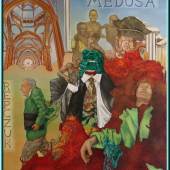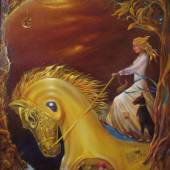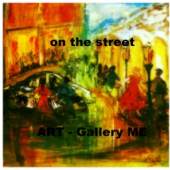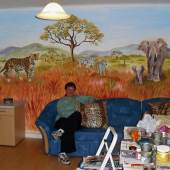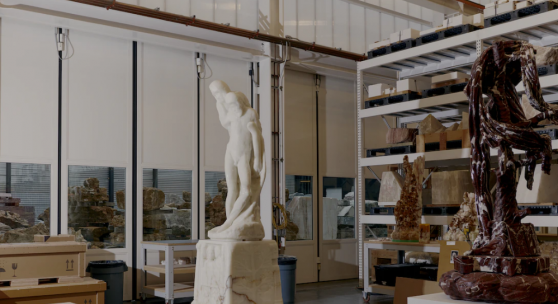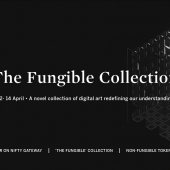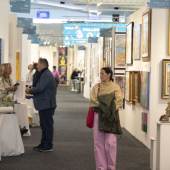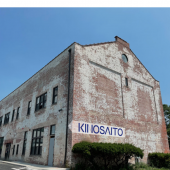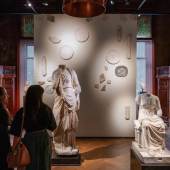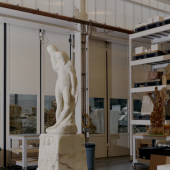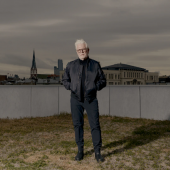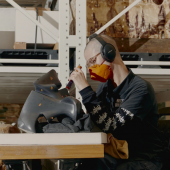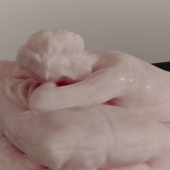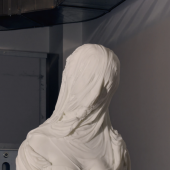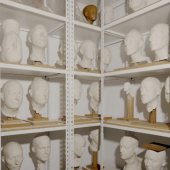In Barry X Ball’s New York Studio, Ancient Sculpture Meets Cutting-Edge Technology
-
Presse21.04.2023
In Barry X Ball’s New York Studio, Ancient Sculpture Meets Cutting-Edge Technology
The artist’s enigmatic works, which aim to improve upon historic masterpieces, are the result of thousands of hours of work by both man and machine
Glancing around Barry X Ball’s three-story, 20,000-square-foot New York studio, one would think they’re on Italy’s Tuscan coast, the heart of the world’s stone industry. A six-ton block of Belgian black marble and some 50 boulders of Mexican (Baja California) onyx—the artist’s favorite stone—are among the 400 blocks amassed over 25 years. “I have my little corner of nature here,” says Ball, who visits Italy between four and six times a year in search of entrancing stones, sourced from international quarries, for his seemingly impossibly detailed sculptures, which can take up to 10,000 hours to craft. “Stone is a bit like real estate. You see a beautiful piece, and you may never come upon it again.”
Beyond rare materials, Ball also looks to Italy for the latest stone cutting technologies. It’s these dichotomies— of old and new, of nature versus man—that are at the core of Ball’s œuvre, a constant quest for perfection, as embodied in his dream studio. Having worked as an artist for more than 40 years in New York, California-born Ball acquired a sprawling 10,000-square-foot warehouse in Greenpoint in 2011. “I took the greatest hits of all the facilities I’d worked in,” explains the artist who worked with the New York practice Andrew Berman Architect for nearly a decade to expand and design the complex. The goal was to incorporate nearly every aspect of his art’s creation, from digital design to the final hand polishing, in one place. “It’s a monstrously involved undertaking to establish your own high-tech stone fabrication facility,” says Ball, whose personal equipment includes twin 20-ton bridge cranes and robot diamond wire saws.
Ball has long been ahead of the curve. Thirty years ago, he began working with 3D scanning and printing as well as robot milling machines for stone carving. “Back in the day, 3D scanning was only available at special effects houses in Los Angeles or in the military,” says the artist. Ball was also given a computer in 1988 as part of the AppleSeed program, which encouraged artists to experiment with digital intervention. From there, computers increasingly became a part of his practice.
While today Ball is best known for his figurative works—both portrait heads of contemporary art-world figures that he admires, and “responses” to past sculptural masterpieces—it wasn’t until the mid-1990s that he abandoned Minimalism and Geometric Abstraction. “I started to imagine what’s the ultimate curved surface, and I thought—the human head,” he recalls of his “Portrait Sculptures,” which realize heads of artists Matthew Barney, Lucas Michael, and Jon Kessler, among others, in vibrant stones, textures, and contortions. “I could approach portraiture in a new way, devoid of all the trappings of power and wealth. Even my female subjects are shown without hair to try to get to the essence of their humanity.” At the time, the artist had to life cast subjects before 3D scanning the derived plasters, but today the process is entirely digital.
During the mid-2000s, Ball began his “Masterpieces” series, which entails 3D scanning historical sculptures housed in museums and private collections and recasting them with decided modifications. “I always advocate that artists historically ground themselves and see the extraordinary things that were done in the past. I want to hold onto everything that the artist did and then subtly push it to another place,” says the artist, who has responded to more than 20 sculptures, beginning with Antonio Corradini’s 18th-century La Purità (Dama Velata) (Purity, Veiled Woman) and Giusto Le Court’s 17th-century La Invidia (Envy) at the Ca’ Rezzonico palazzo, the Museum of 18th Century Venice. Ball especially admires how ancient sculpture was often born out of royal and noble patronage, when commissions were not always constrained by neither time nor budget. “To know that for The Gates of Paradise, Lorenzo Ghiberti spent 27 years working on the bronze doors of the Florence Baptistery. He was aiming for something superhuman. Those kinds of standards are my guideposts.”
In exchange for access to their prized sculptures, Ball gives institutions all the scan data for conservation and restoration purposes, making the collaboration mutually beneficial. Equipped with this information, Ball imagines how the original artists could have improved upon their works. After scanning Niccolò dell’Arca’s 15th-century Il Compianto sul Cristo morto group in the Sanctuary of Santa Maria della Vita in Bologna, Ball not only smoothed Mary Magdalene’s and the other figures’ flowing drapery, but also created a back for the sculptures. “I hadn’t realized the figures were originally hollow façades, so we sculpted them in the round,” says the artist. When working on Umberto Boccioni’s 1913 Unique Forms of Continuity in Space at The Metropolitan Museum of Art, Ball wanted “to take the artist’s super-rough plaster casts where he could never have afforded to go.” The Italian Futurist tragically died at 34 before he had the means to realize any of his sculptures in a permanent material. “I wanted to make their surfaces perfect.”
-
12.04.2021 - 14.04.2021By Pak • 12- 14 April • A novel collection of digital art redefining our understanding...
-
20.04.2022ARTEXPO NEW YORK CELEBRATES ITS 45TH ANNUAL EDITION WITH A RENAISSANCE IN CONTEMPORARY AND FINE...
-
23.05.2018NEW YORK, 16 May 2018 – Today, Sotheby’s is honored to unveil the full contents of A...
-
The art space’s two galleries will host exhibitions that rotate three times a year. One...
-
15.03.2025 - 20.03.2025Die TEFAF (The European Fine Art Fair) ist eine der weltweit renommiertesten Kunst- und...
-
21.04.2023Presse »
.
